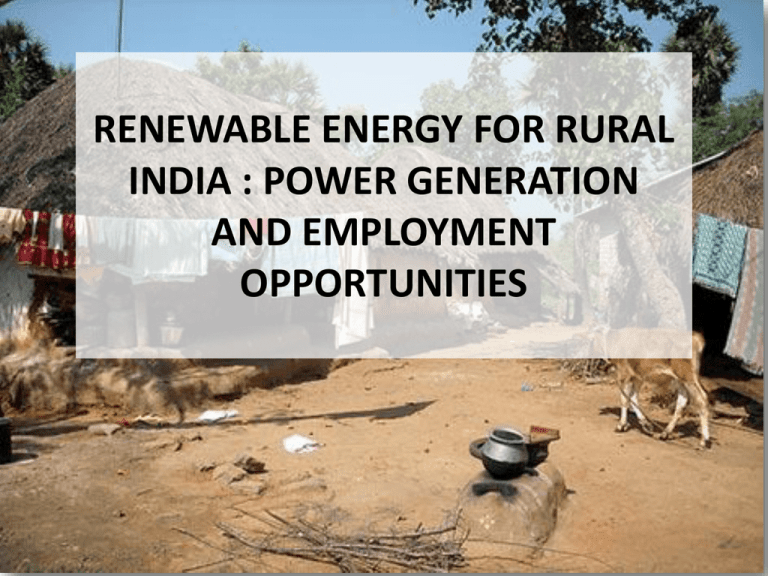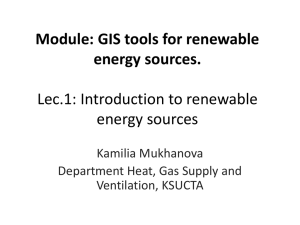renewable energy for rural india : power generation and
advertisement

RENEWABLE ENERGY FOR RURAL INDIA : POWER GENERATION AND EMPLOYMENT OPPORTUNITIES PREVIEW • Benefits of Rural Electrification. • Why Renewable Energy? • Hybrid Power Plant off grid Solutions for Rural India. • Finance • Employment Generation 2 INTRODUCTION A Day in The Life of a Woman in Rural India 3 DEFINITION OF RURAL ELECTRIFICATION • The basic infrastructure within the revenue boundary of the village. • Any of the public places avail power supply on demand. • The ratings of distribution transformer and LT lines decided in consultation with the Panchayat/Zila Parishad/District Administration. • The number of household electrified should be minimum 10% for villages which are unelectrified, before the village is declared electrified. The revision of definition would be prospective. India's Installed Power Capacity -2013(Mega Watts) Coal Hydro Total Capacity (MW) 132,288.39 39,623.40 RES 27,541.71 12.20 Gas Nuclear Oil Total 20,359.85 4780 1,199.75 2,25,793.10 9.02 2.12 0.53 Source Percentage 58.59 17.55 Benefits of Rural Electrification 10 Buzz word of this decade GO GREEN Awake……Awake….. TOP RENEWABLE ENERGY SOURCES WIND ENERGY TIDAL ENERGY SEA WAVE ENERGY SOLAR ENERGY TOP RENEWABLE ENERGY SOURCES BIO MASS ENERGY GEO THERMAL ENERGY HYDRO ENERGY Green Power • Environment friendly • Reduction in Green House gas as compare to 1 MW of a Coal Power Plant vis a vis 1 MW of Wind Energy Plant per annum – 1338 tons of Carbon-di-oxide – 17 tons of Sulphur Oxide – 4 tons of Nitrogen Oxide – 966 tons of Ash • Potential to get approx. 7000 CERs per MW Renewable Energy Deployment Wind installation (global) 160,000 MW (cumulative) India’s share (and position) 20000 MW(fifth in the world) SPV cell production (global) 11,700 MW India’s share (and position) (seventh in the world) Biogas plants (global) 56 million units (cumulative) India’s share (and position) 3.9 million family size units (second in the world) Solar Thermal (global) 110 million sq.m (cumulative) India’s share (and position) 1.65 million sq. m (ninth in the world) Source: Ministry of New and Renewable Energy Potential and Installed Capacity- RES In MW 60000 50000 150000 105000 40000 30000 30000 Potential Installed 20000 20700 15000 10000 3200 3000 Small Hydro Biomass 0 Wind 982 Solar Contribution of Various RES in 2013 Power Wind 2% 14% Small Hydro 14% 70% Bio Mass & Waste Solar Small Hydro Power Small Hydro Power in India Solar Energy Global solar radiation over India Bio Mass Biomass is a renewable energy source that is derived from living or recently living organisms. Biomass includes biological material, not organic material like coal India’s climatic conditions offer an ideal environment for biomass production. Biomass can be chemically and biochemically treated to convert it to a energy-rich fuel Bio-energy has remained critical to India’s energy mix, with a total installed capacity of 3000 MW. The total biomass & waste energy potential in India has been estimated at over 30,000 MW. Bio Mass Small scales. Off grid Can replace costlier heating options like furnace oils India has an estimated potential of over 30,000 MW of power from biomass, but around 3000 MW has been exploited. Thus, over 90 percent of potential capacity lies untapped Advantage/Disadvantage Advantages • Renewable resource • Reduces landfills • Protects clean water supplies • Reduces acid rain and smog • Reduces greenhouse gases Disadvantages • Biomass has a smaller energy content for its bulk than fossil fuels • Costs of labor, transportation, and storage would then be higher Biomass emits carbon dioxide when it naturally decays and when it is used as an energy source Living biomass in plants and trees absorbs carbon dioxide from the atmosphere through photosynthesis Biomass causes a closed cycle with no net emissions of greenhouse gases BIOMASS LOGISTICS • Operations necessary to move biomass feedstocks to the energy plant and to ensure that the delivered feedstock meets the specifications of the conversion process. • Generally the biomass is trucked directly from farm to biorefinery. • Aim to minimise number of passes; reduce moisture content and increase the bulk density of biomass. 37 EMPLOYMENT OPPORTUNITIES Wind Energy India’s Success Story in Wind: 5th Biggest in World Estimated potential up to 100000 MW (@ 80 m Hub ht) Represents 70% of total renewable energy installation in country. Current Installed base of 20000 MW • In FY 12-13 more than 1800 MW- investment Rs 20000 crore. 4th in the world • Contributed 119 Billion units of wind elect to grid till date • During FY 12-13, 23.35 billion units offsetting 18.91 million tones of CO2 1995 470 MW 2000 1170 MW Entire investment by Pvt sector. 2005 4388 MW April 2012 17300 MW Apr 2013 20000 MW Growth of wind energy in India Ref: MNRE data Wind Zones in India Missing Link – Renewable Energy HYBRID RENEWABLE ENERGY SOLUTIONS Why Hybrid? 1. The sun shines in the day. 2. The wind is ever changing and never constant. 3. Bio mass cannot function in very cold weather. 4. MHP will have more water seasonally. 44 Purpose In order to stabilize the power source, Wind and Solar energy which depend on weather conditions Biomass energy which can be stored and its input regulated Triple hybrid renewable energy generation system Triple Triple hybrid hybrid renewable renewable energy energy generation generation system system 45 HYBRID POWER PLANT SOLUTIONS • Hybrid renewable energy systems (HRES) popular for remote area power generation applications. • Consists of two or more renewable energy sources used together. • Increased system efficiency. • Greater balance in energy supply. • Grid connecting India is a very costly proposition at present. Hence need for offline/decentralised grids. 46 SOLUTION FOR A 1000 HOUSE HOLD SMALL VILLAGE OFF GRID • Average energy reqmt of 1000 units per year per family. A total of 1 million units a year. • Can be met by a 600 KW Wind Turbine in a wind zone. • Can be met by a 1 MW Solar Plant in most of India. • Ideally needs to be met by a hybrid renewable energy plant. 47 SOLUTION FOR A 1000 HOUSE HOLD SMALL VILLAGE OFF GRID • Suggested solution incl the offline grid:- • A 200 KW Wind Turbine costing Approx Rs 1 Cr. Generating about 0.4 million units. • A 200 KW Solar Plant costing approx Rs 1.2 Cr. Generating about 0.3 million units. • A 200 KW biogas plant generating approx Rs 0.8 Cr to meet the balance requirement. • Total Cost of Rs 3 Crs approx about Rs 30 Thousand per household. 48 SOLUTION FOR A 1000 HOUSE HOLD SMALL VILLAGE OFF GRID • In addition each house hold to be given a mix of solar lanterns, solar stoves and dryers as required. • Initial investment to be met by Govt through Private Industry using a mix of subsidy, tax depreciations and generation based incentives. • Charging at Rs 4 per unit would recover about Rs 40 lacs per year from the village. Thus the break even of the project would be 7 to 8 years. 49 EMPLOYMENT GENERATION • Employment generation occurs while constructing the grid, installing the wind/solar farm, O&M of the plant. • Employment occurs due the logistics of procuring biomass. • The biggest employment generation takes places due to freeing women from drudgery and starting of home businesses. • The force multiplier is enhanced education permeating through villages. 50 EMPLOYMENT GENERATION • According to Greenpeace, Global Wind Energy Council and European Renewable Energy Council's joint 2012 report, approximately 2.4 million jobs can be created in India in 2020 from growth in the renewables market. Importantly, this report points out that renewable energy has the potential to significantly grow the labor market, as clean technologies are generally more labor-intensive and will consequently create more domestic jobs as the market grows. 51 EMPLOYMENT GENERATION • MNRE 2010 human resources report projects renewables employment to increase nine-fold to reach 20 million jobs by 2030, with biomass leading the growth at 59% of total capacity, followed by solar PV at 31%. 52 EMPLOYMENT GENERATION: HSBC REPORT • India’s Green Energy market will create 10.5 million green jobs. • Expected to treble to INR 351,000 crore (USD 77 billion) in the next ten years. • India fifth in the world in exploitation of wind. • Bold low carbon policies needed . • Advantage of Low cost labor and a highly skilled manufacturing base. • The rate of increase of India’s private investment in clean energy will be 736% over the next ten years - three times that of US or China. 53 National Level Economics for a Rural Offline Power Deficiency Removal • Today about 7.8 crore house holds need to be powered. • @ 30 thousand per household this translates into an investment of approx Rs 2.4 lac crores. • This is approximately about 3 percent of India’s GDP. • Over the last 20 years to provide 20 GW of Wind Power pvt industry has invested Rs 1.2 lac crores. “So the money is available”. Govt policies however placed impediments in 2012. 54 National Level Economics for a Rural Offline Power Deficiency Removal • Pvt Industry has the funds to invest. • What they need is a steady IRR. • This can be met through tax depreciations and GBI. • It also needs security of its investments in rural India. • Unless land issues are depoliticized infrastructural growth in India will crawl. • 55 STANDALONE MINIGRIDS : ADVANTAGES •Can reach remote areas. •More cost effective than large distance grids. •Less distribution losses. •Can hook on national grid once extended. •Involves community integration and participation. 56 • Govt Subsidies. • International development and Finance Organisations. • Social Entrepreneurs. • Electrical companies trying to expand business. • Carbon credit finance. 58 59 CONCLUSION 60








